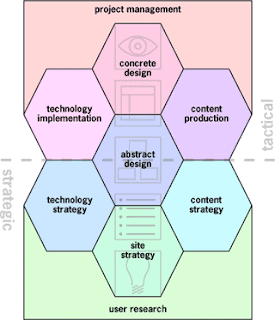At last week's UXPA Scotland session, we were lucky enough to have author and content strategist Rahel Anne Bailie. Her talk prompted a bit of food-for-thought for me, and highlighted a few resources and bits of follow up reading.
Rahel started by putting content strategy in context - where she felt the discipline evolved from, how it fits in alongside others and what it's meant for her in a career that began in technical writing.
For her, the Elements of User Experience (a favourite model of mine by J J Garrett) doesn't given the strategy and process of content management enough weight, which I suppose is fair enough when viewed from a content strategist's perspective. Development of an information-driven website or application would need to give far more attention to this area, and Garrett's model is one-size-fits-all.
Previous post: Elements of user experience model
For Rahel, the Adaptive Path 9 pillars hexagon model is a better representation of relationships.
 |
| 9 pillars of web design by J J Garrett (www.adaptivepath.com) |
Previous post: Web teams - the essential skills
She spoke about the importance of context. How for content to have real value and be truly re-usable understanding of context is essential. She defined:
Data + context = content
Content + context = information
Info + context = knowledge
And with context comes the ability for content to exist within a lifecycle.
Content Lifecycle: Closing the loop in content strategy - article by Rahel Bailie for JohnnyHolland.com
She also talked around the concept of Create Once Publish Everywhere (COPE). I took from what she said that while this is a great concept, and an essential one to embrace and develop in the coming years as the number of devices and contexts if content consumption multiply, we are a lot way off achieving it.
There are neither the technical tools, nor enough expertise a understanding available right now for organisations to really make a good job of it. This segment put me in mind of the webinar I'd recently seen by Karen McGrane on future proof content and her example of the challenges Amazon were looking to overcome with small screen interaction.
Previous post: The future of content management
Rahel talked about content management systems not currently being up to the job. Or indeed, content management systems not even being the right tool in the first place. She gave a good analogy about developers saying "we'll just get the CMS to..." - It's like describing needs addressed by a helicopter to car manufacturers who then go about evolving their car design (in a world where helicopters don't exist).
My one criticism of the session was that it all felt quite exclusive. Kind of, 'this is hard stuff and only the experts can do it' which to me is a non-starter in the world of ever-growing non-specialist management if content. I suppose she was talking to a user experience professionals group though, so perhaps would have had a different message for a different audience.
I asked probably the least specialist question of the evening, and was disappointed with the answer. I was looking for a bit of inspiration to take back to the University web publishing community. The kind of message Steve Krug does so well in the usability arena - "The least you can do about usability" and all that. I can't even remember the response as I couldn't jot anything focused down.
However, I think Rahel actually gave quite a good response to my question, to a subsequent question which related to how a consultant can make the case to their client to invest in content strategy work.
Rahel advised to focus on the return on investment of content strategy. To focus where the business-critical, high value content is. This is much like what Lou Rosenfeld said in his IA presentation about where to focus attention, likening it to the skins of an onion.
Related post: Avoiding your next site redesign
Another question at the end of her presentation was about content strategy for translations, to which Rahel made a good point in support of plain English. If you're going to rely on cheap translation services, or on users translating themselves using free online services you need to write for low literacy.
Tips on writing for an international audience - Yours Truly International by Rahel Bailie (PDF)
And finally, here are the slides Rahel talked through:
No comments:
Post a Comment